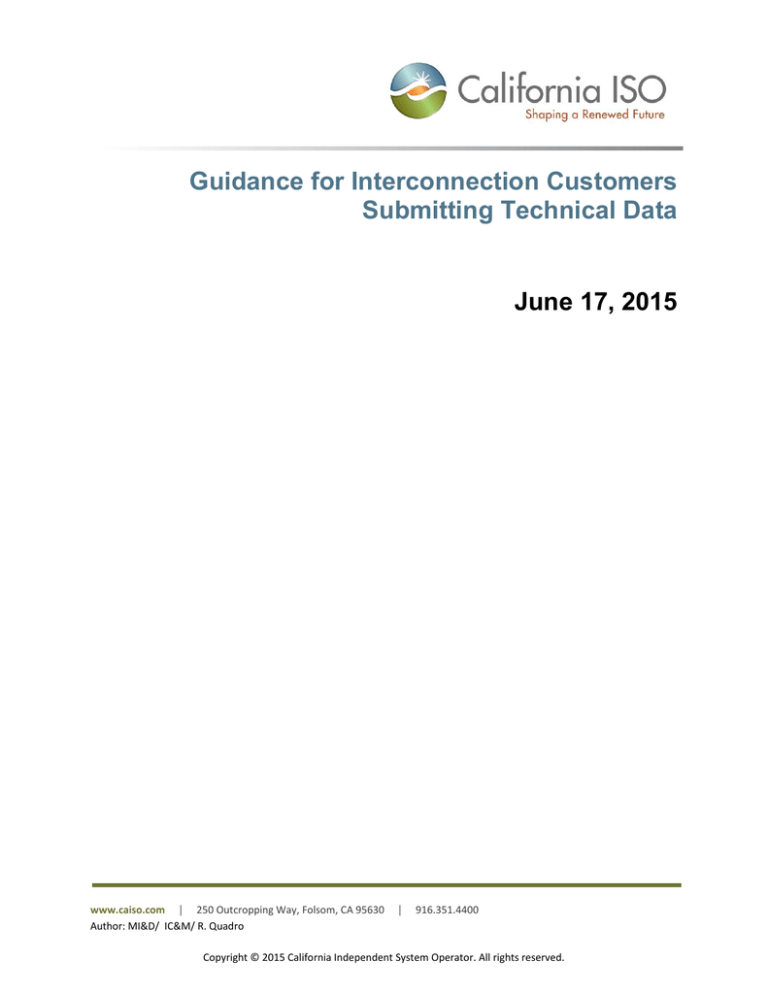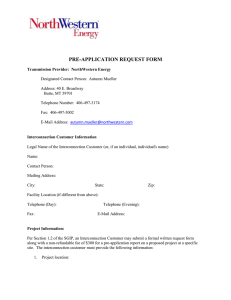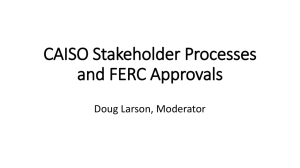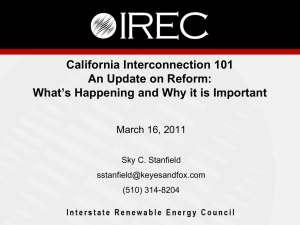
Guidance for Interconnection Customers
Submitting Technical Data
June 17, 2015
www.caiso.com │ 250 Outcropping Way, Folsom, CA 95630
Author: MI&D/ IC&M/ R. Quadro
│
916.351.4400
Copyright © 2015 California Independent System Operator. All rights reserved.
Guidance for Interconnection Customers Submitting Technical Data
June 17, 2015
Revision History
Date
4/20/2015
Version
1
Description
Published initial version
Author
R. Quadro
Note: This technical guidance is provided for the convenience of the interconnection
customer for the purpose of communicating complex and technical information. The guidance
is intended to be consistent with the ISO tariff, however, the ISO is bound to operate in
accordance with the tariff in all cases. In the event there is any conflict between guidance and
the ISO tariff, the ISO tariff will control.
Table of Contents
BACKGROUND .................................................................................................................................................. 3
GENERAL ITEMS ............................................................................................................................................... 3
SPECIFIC ITEMS ................................................................................................................................................ 4
www.caiso.com
Author: MI&D/ IC&M/ R. Quadro
Copyright © 2015 California Independent System Operator. All rights reserved.
Page 2 of 6
Guidance for Interconnection Customers Submitting Technical Data
June 17, 2015
Background
This document outlines the specific items that are the most common cause of
deficiencies when an Interconnection Customer (IC) submit an Interconnection Request
(IR), one-line diagrams, and technical data (PSLF files) to the CAISO.
Incomplete, inaccurate, or otherwise unacceptable data leads to delays and the risk of
IRs being deemed invalid and not studied for customers submitting new IRs in the
annual Interconnection Request Window, the Fast Track process, or the Independent
Study Process. These deficiencies are also the most common factor that cause
Material Modification Assessment requests (MMAs), Repowering requests, and other
modification requests to go beyond the respective tariff and Business Process Manual
(BPM) defined timeframes that the CAISO and the Participating TO have to review and
respond to the request.
The CAISO and the Participating TO will work with the IC to resolve deficiencies and
questions about technical data and diagrams as soon as possible after receipt. It is
adventageous for the IC to provide its IR prior to the cluster window closing so that it
has more time to address any deficiancies in its IR submittal. The ISO Generator
Interconnection and Deliverability Allocation Procedures (GIDAP) Tariff, Appendix DD,
states – “If an Interconnection Request has not been deemed valid, the Interconnection
Customer must submit all information necessary to meet the requirements of Section
3.5.1 no later than twenty (20) Business Days after the close of the applicable Cluster
Application Window.”
Prior to submitting the technical data and associated diagrams, the IC may want to
review the IR and associated technical data with the following considerations in mind.
This is a list of the most frequent items that require correction:
General Items
CAISO Tariff Appendix DD, Attachment A to Appendix 1 received from the IC is
not the latest IR template. The latest IR template is on the CAISO website at:
http://www.caiso.com/Documents/GIDAPAppendix1-AttachmentA-Appendix1InterconnectionRequest-GeneratingFacilityData.doc
All sections of Appendix 1 and Attachment A must becompleted. If a section is
not applicable, please mark it as N/A.
www.caiso.com
Author: MI&D/ IC&M/ R. Quadro
Copyright © 2015 California Independent System Operator. All rights reserved.
Page 3 of 6
Guidance for Interconnection Customers Submitting Technical Data
June 17, 2015
Even if the Modification request is limited in scope, the IR (including one-line
diagram and PSLF files) should represent the whole project.
Review the sample completed IRs on the ISO website for instructive examples of
correctly completed IRs using the link below:
Interconnection Request Resources
Specific Items
Dynamic data does not use the GE PSLF v18.1 WECC approved dynamic
models. Because of a limitation on the number of user-defined models that can
be used by the CAISO and Participating TOs, user defined models may only be
submitted in the case that GE PSLF library does not contain the model for the
technology of the Generating Facility.
o If you require assistance in developing the models, we suggest you
contact General Electric directly. Accurate models are important to obtain
accurate results. Costs associated with any changes in facility
requirements that are due to differences between model data provided by
the generation developer and the actual generator test data, may be the
responsibility of the generation developer.
Inconsistent values between Attachment A Sections 10/10a and epc file power
flow data
o Attachment A Sections 10 and 10a request Line Charging (B/2) in per unit.
The epc power flow data file format is total line charging B in per unit. The
value in the epc file must be 2 times the value in the IR.
A project that is required to meet 0.95 lead/lag at the POI as per its Phase I or
Phase II study results must demonstrate through the data in the IR package, how
this will be accomplished.
There are inconsistent values between attachment A and the load flow and
dynamic models:
Inconsistent values between Attachment A Section 4c vs dynamic data
Failure to model aux load in EPC files. Auxiliary load is not intended to represent
losses in the project transformers/collector circuits/gen tie lines/etc. Auxiliary
load is intended to represent other loads at the Generating Facility
(motors/pumps/etc…) that are served from the grid if the generator is not
operating.
www.caiso.com
Author: MI&D/ IC&M/ R. Quadro
Copyright © 2015 California Independent System Operator. All rights reserved.
Page 4 of 6
Guidance for Interconnection Customers Submitting Technical Data
June 17, 2015
Project has two different kinds of inverters, but the model of the project includes
only one aggregated unit and aggregated inverters. Aggregated modeling is
acceptable provided that the dynamic models, short circuit duty contribution,
terminal voltages, and same MVA base are the same for all inverters. If they are
different, then there must be two separate models.
Updated single-line diagram was not provided, or did not contain enough detail.
o Single-line diagram showing applicable equipment such as generating
units, step-up transformers, auxiliary transformers, switches/disconnects
of the proposed project, including the required protection devices and
circuit breakers. For wind and photovoltaic Generator Facilities, the one
line diagram should include the distribution lines connecting the various
groups of generating units, the generator capacitor banks, the step up
transformers, the distribution lines, and the substation transformers and
capacitor banks at the Point of Interconnection with the CAISO Controlled
Grid.
o Parameters shown on the one-line diagram do not match data in other
sections of Attachment A to Appendix 1, e.g. different transformer
impedances and MVA bases.
Please provide supporting manufacturer’s documentation and Max Short Circuit
Duty Capability information for Short Circuit Duty Analysis for change in Inverter.
o Provide information on “Stand-Alone Operation” capability of Inverter.
o The provided short circuit fault contribution for asynchronous generators in
the IR should include Low Voltage Ride Through (LVRT) capabilities.
For MMA requests, include proposed In Service Date (ISD) in addition to the
proposed Commercial Operation Date (COD) in Appendix 1 and also in other
documents requesting changes in milestone dates.
The IR states that Appendix 1, item 4b should be equal to Appendix 1
Attachment A, item 2C. Also, item 2C must equal the data in item 2A lessitem
2B. But item 2 C does not take into account losses within the project. The IR
should be completed as follows:
o Item 2A, Total Generating Facility rated output (MW): the gross output
number at the generator terminals. Typically the inverter MW capacity
provided by the manufacture is under the unity power factor. The MW
capacity under a different power factor is lower than that under the unity
power factor. If the IC uses the inverters to meet the reactive power
www.caiso.com
Author: MI&D/ IC&M/ R. Quadro
Copyright © 2015 California Independent System Operator. All rights reserved.
Page 5 of 6
Guidance for Interconnection Customers Submitting Technical Data
June 17, 2015
capability requirement, please clearly indictate the MW capacity and the
associated power factor.
o Item 2B, Generating Facility auxiliary load (MW) : auxiliary load that does
not include any losses, instead it is actual loads that are modeled
explicitly.
o Item 2C, Project net capacity (MW, 2A-2B): the IR states that this should
be equal to Appendix 1 item 4b which is the desired maximum output for
the project. This is a net value and doesn’t account for losses. The net
output to the grid is really Gross output at generator terminals – Generator
Auxiliary load – Losses on the IC side of the POI. The IR does not specify
the Losses component. Instead the transmission loss is calculated using
the power flow model submitted by the IC.
o All energy storage projects must submit the technical data in accordance
with the “Supplemental Information for Energy Storage Projects”
document provided at the following link:
http://www.caiso.com/Documents/EnergyStorageProjectsSupplementalInformation.pdf
The IR should include current data to capture the following characteristics of
Wind Turbines and PV inverters in order to determine their fault contribution :
Isc max current during fault detection.
Duration of Isc max
Isc max after fault detection
Ilv max current for low voltage ride through (LVRT).
Duration of Ilv max
www.caiso.com
Author: MI&D/ IC&M/ R. Quadro
Copyright © 2015 California Independent System Operator. All rights reserved.
Page 6 of 6






